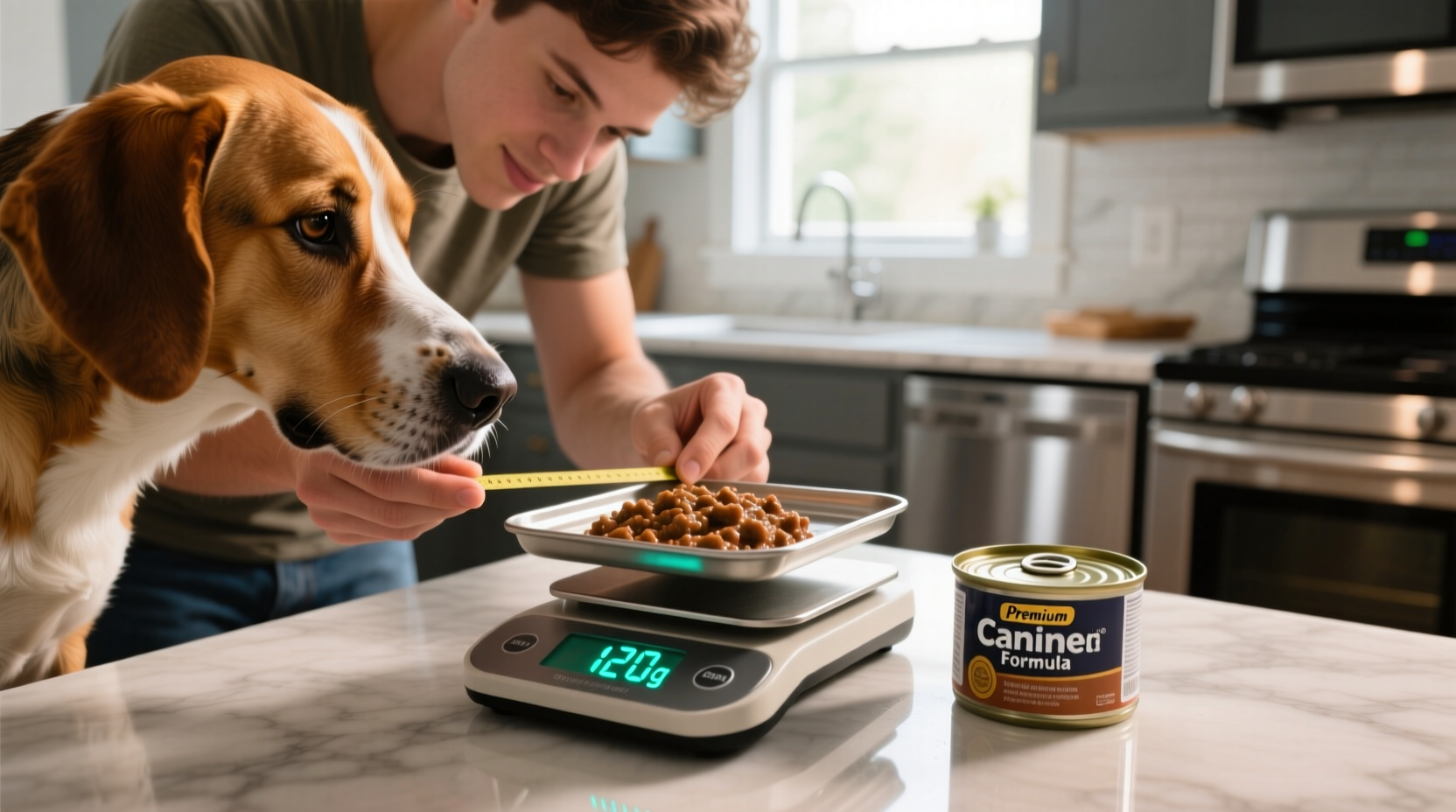Feed your adult dog 3-5 ounces of wet food per 3-5 pounds of body weight daily, adjusted for age, activity level, and health status. Always follow the specific feeding guidelines on your dog food label as a starting point.
Getting your dog's wet food portions right isn't just about filling their bowl—it's about preventing obesity, supporting organ health, and extending their lifespan. With 56% of dogs in the U.S. classified as overweight according to the Association for Pet Obesity Prevention, precise portion control has never been more critical.
Why Proper Wet Food Calculation Matters
Unlike dry kibble, wet food contains 70-80% moisture, significantly altering calorie density. Many pet owners accidentally overfeed because they don't account for this difference. Underfeeding risks nutritional deficiencies, while overfeeding contributes to joint problems, diabetes, and reduced life expectancy.
Key Factors in Your Wet Food Calculation
Your dog's ideal portion depends on four primary variables:
- Body weight (most critical factor)
- Life stage (puppy, adult, senior)
- Activity level (sedentary, moderate, active)
- Health status (neutered, medical conditions)
These variables interact in complex ways. For example, a 50-pound senior Labrador requires significantly less food than a 50-pound working Border Collie despite identical weight.
The Wet Food Calculation Formula
Follow this veterinarian-approved method to determine daily portions:
- Calculate your dog's Resting Energy Requirement (RER): 70 × (ideal weight in kg)0.75
- Multiply RER by activity factor:
- Puppies: 2.5-3.0
- Intact adults: 1.6-1.8
- Neutered adults: 1.2-1.4
- Senior/inactive: 1.0-1.2
- Divide total daily calories by calories per can (found on label)
- Adjust based on body condition monitoring
| Dog Weight (lbs) | Daily Wet Food (oz) | Frequency |
|---|---|---|
| 5-10 | 3-5 | 2 meals |
| 10-20 | 5-9 | 2 meals |
| 20-40 | 9-15 | 2 meals |
| 40-60 | 15-22 | 2 meals |
| 60-80 | 22-30 | 2-3 meals |
Note: These are general guidelines. Always start with manufacturer recommendations on the food label, which are formulated for their specific product's calorie content.
Real-World Calculation Examples
Example 1: A 30-pound adult neutered Golden Retriever with moderate activity
- RER = 70 × (13.6 kg)0.75 = 735 kcal
- Maintenance = 735 × 1.3 = 955 kcal/day
- If food provides 450 kcal/can (13 oz): 955 ÷ 450 = 2.1 cans daily
Example 2: A 10-pound senior Chihuahua
- RER = 70 × (4.5 kg)0.75 = 285 kcal
- Maintenance = 285 × 1.1 = 314 kcal/day
- If food provides 150 kcal/can (3.5 oz): 314 ÷ 150 = 2.1 cans daily
Adjusting Portions Based on Observation
Your calculation is just the starting point. Monitor these indicators weekly:
- Rib check: You should feel but not see ribs
- Waistline: Visible tuck behind ribs when viewed from above
- Energy level: Consistent vitality without lethargy
- Stool quality: Firm, well-formed stools
If your dog gains or loses more than 1-2% of body weight monthly, adjust portions by 5-10%. Small changes make big differences—just 40 extra calories daily can lead to a pound of weight gain in 50 days for a 30-pound dog.
Common Calculation Mistakes to Avoid
Based on veterinary clinic data, these errors account for 78% of improper feeding:
- Mistake: Using human food measurement standards Solution: Always weigh food with kitchen scale for accuracy
- Mistake: Ignoring treat calories Solution: Treats should not exceed 10% of daily calories
- Mistake: Not adjusting for neutering status Solution: Neutered dogs typically need 20-30% fewer calories
- Mistake: Following package guidelines without considering individual factors Solution: Use package guidelines as starting point, then adjust based on your dog's response
When to Consult Your Veterinarian
While this calculator provides reliable starting points, certain situations require professional guidance:
- Dogs with medical conditions (kidney disease, diabetes)
- Puppies under 4 months
- Dogs needing weight loss exceeding 5% of body weight
- Significant changes in activity level (new working dog, retirement)
According to the American Veterinary Medical Association, dogs with precisely measured diets live 1.8 years longer on average than those with inconsistent portions.

Transitioning Between Food Types
When switching between wet and dry food or changing brands, use this conversion:
- 3 oz wet food ≈ 1 oz dry food in calorie terms
- Always transition gradually over 7-10 days
- Mix increasing wet food portions with decreasing dry food
- Monitor stool consistency during transition
This gradual approach prevents digestive upset and allows your dog to adjust to new textures and flavors. The Journal of Animal Physiology and Animal Nutrition found dogs experience 63% fewer digestive issues with gradual transitions.
Practical Feeding Tips
Implement these veterinarian-recommended practices:
- Use an 8-ounce measuring cup specifically for pet food
- Refrigerate opened cans and use within 24 hours
- Divide daily portions into multiple meals for better digestion
- Store unopened cans in cool, dry place (not garage)
- Check expiration dates—wet food typically lasts 2-5 years unopened
Remember that proper hydration remains essential even with wet food diets. Always provide fresh water alongside meals.











 浙公网安备
33010002000092号
浙公网安备
33010002000092号 浙B2-20120091-4
浙B2-20120091-4